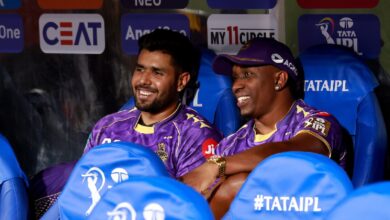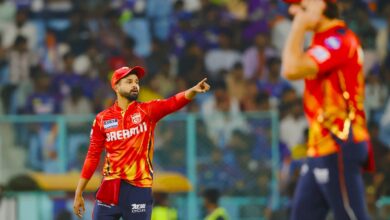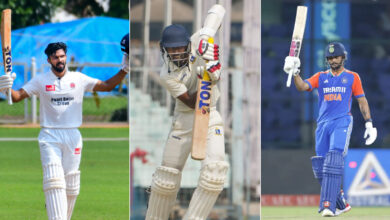Nostalgia at Sharjah stadium: From a Guinness record to now playing to empty stands | Cricket News

The hashtag #ItAllStartedHere that adorns the cream coloured walls of the Sharjah Cricket Stadium says it all. From 1984 to 2001 — when the Indian government banned the Men in Blue from playing there – it had been the epicentre of cricket. If World Series Cricket or the tri-series were synonyms with the Australian summer, so were the multi-national tournaments in Sharjah, played under the name Cricketers Benefit Fund Series (CBFS). For Indians, any mention of Sharjah in a conversation doesn’t end without the mention of Javed Miandad’s last-ball six in 1985 or Sachin Tendulkar’s Desert Storm in 1998.The empty stands, which are now aged and a throwback to a different era, used to drum up such an electric atmosphere that it made Tony Greig scream on air, “They are dancing in the aisles in Sharjah,” when Tendulkar was in full flow in 1998. Decades have gone but the Sharjah Cricket Stadium still stands intact. With Dubai and Abu Dhabi having modern stadiums it isn’t the most sought after these days, but it still remains the heartbeat of cricket in the middle-east.
The old scoreboard has given way to an electronic one, which seems to be the only upgrade. Those hoardings over the canopies which famously used to give away the next scheduled tri-series in the city are still around. So is the one-storied stand behind the sight-screen on one end, where one of Tendulkar’s sixes off Michael Kasprowicz landed in the final got Greig going, “Ohhhhh this is high, what a six! What a six! Way down the ground, it’s on the roof. It is bouncing on the roof.”
Story continues below this ad
The empty stands, which are now aged and a throwback to a different era, used to drum up such an electric atmosphere that it made Tony Greig scream on air, “They are dancing in the aisles in Sharjah,” when Tendulkar was in full flow in 1998. (Express Photos Venkata Krishna B)
Those were the glory days of Sharjah. Now, the stadium resembles an old din that has clearly seen its best days. Apart from the numerous photographs – which don’t have a contemporary active international cricketer — that adorn the walls, there is nothing to indicate how this venue used to be a stopover for most teams every year. In the case of India and Pakan, there have also been instances where they have played two series in a calendar year, much to the excitement of the numerous expats who live here.
“Cricket has been going on in Sharjah for over 50 years now,” Mazhar Khan who is the general manager of the Sharjah Cricket Stadium says. “In 1974, we were the first club to invite teams from overseas with a State Bank of India team arriving here in 1975 and PIA in 1976. Then Abdulrahman Bukhatir thought why not invite the international teams of India and Pakan. They decided to have this benefit purse in Sharjah, which started in the 1980s. And that way, retired players who had represented India and Pakan, used to get a purse of $50,000. That’s how it started and it continued till 2000,” Mazhar says.
With the tensions boiling over in the stands, the venue has had a habit of segregating the Indian and Pakan fans separately to avoid any incidents. For a long time it just had concrete seats, but with time they put in those bucket seats which were ravaged Afghanan and Pakan fans when they played a Asia Cup fixture here in 2018. “The security department here, they know that it’s better to separate them. Especially when you play Afghanan, even India or Pakan, they always prefer to keep them aside. So, there are no issues amongst them,” Mazhar says.
Since that first ODI between Pakan and Sri Lanka in 1984, it has hosted more than 300 international fixtures (which finds a place in Guinness world records which also includes around 253 ODIs, the most any venue has hosted. In 2001, after the match-fixing saga, the Indian government banned its team from playing in the city, which continues till date. That ban meant, between April 2003 and February 2010, it didn’t host a single international fixture. The drought would only be ended Afghanan, which used the venue as its home base during its initial years.Story continues below this ad
Though India has long stopped visiting the city, with Dubai being its favoured destination for cricket in the middle-east these days, Sharjah has somehow still managed to hold its relevance. (Express Photos Venkata Krishna B)
“In those days, it was easier to request the Indian and Pakan boards to come and play because there was no FTP. But with the amount of cricket these days, it is impossible. So Sharjah had its own time. But even now, we are hosting internationals. Last year, the ICC used the venue for the Women’s T20 World Cup. Before that the IPL happened here,” Mazhar says.
Though India has long stopped visiting the city, with Dubai being its favoured destination for cricket in the middle-east these days, Sharjah has somehow still managed to hold its relevance. Owned privately, the stadium has a self sustainable model in place where the venue is rented for matches and even for entertainment shows.
“We are a privately owned stadium so unless we host matches it is hard to maintain it. So, that’s why we try to keep the stadium busy with not only international games, but also allow entertainment shows and corporate matches to happen. On an average, we play about 225, 30 games in a year, which includes our domestic season,” says Mazhar.
On Thursday one such game was underway with eerie silence for company. Nobody was dancing in the aisles.







